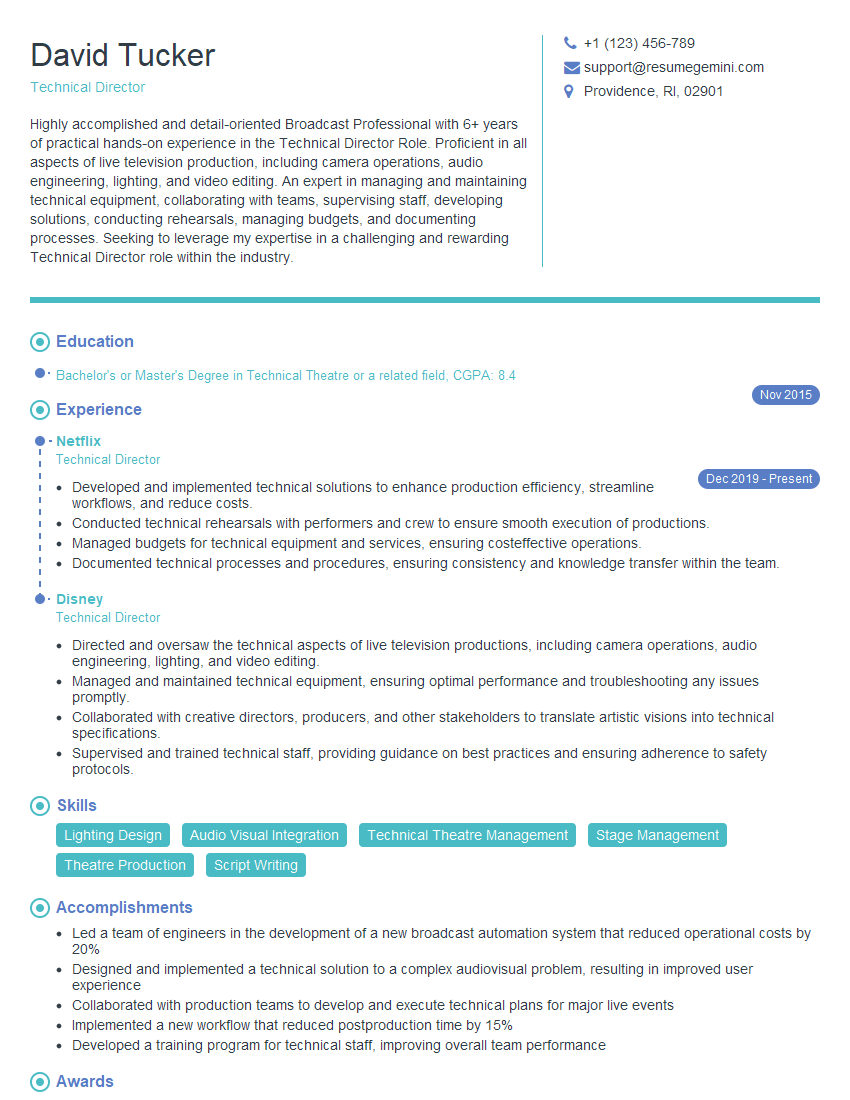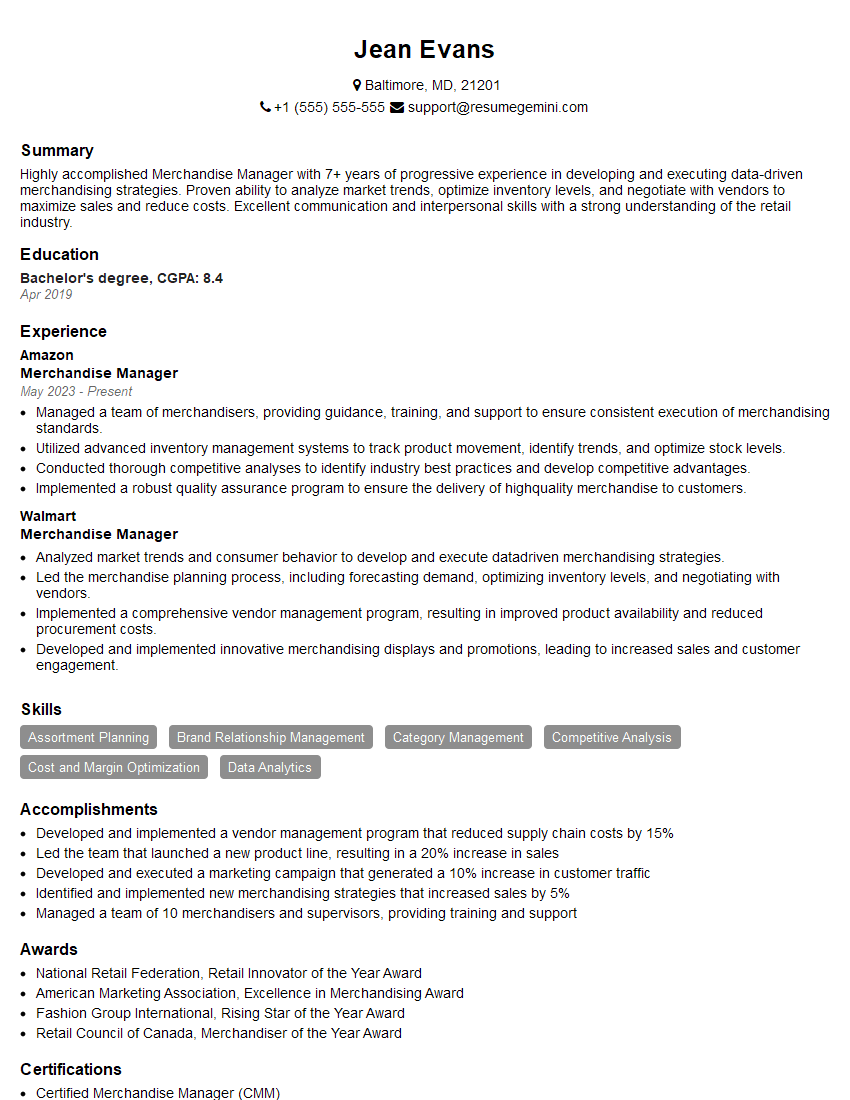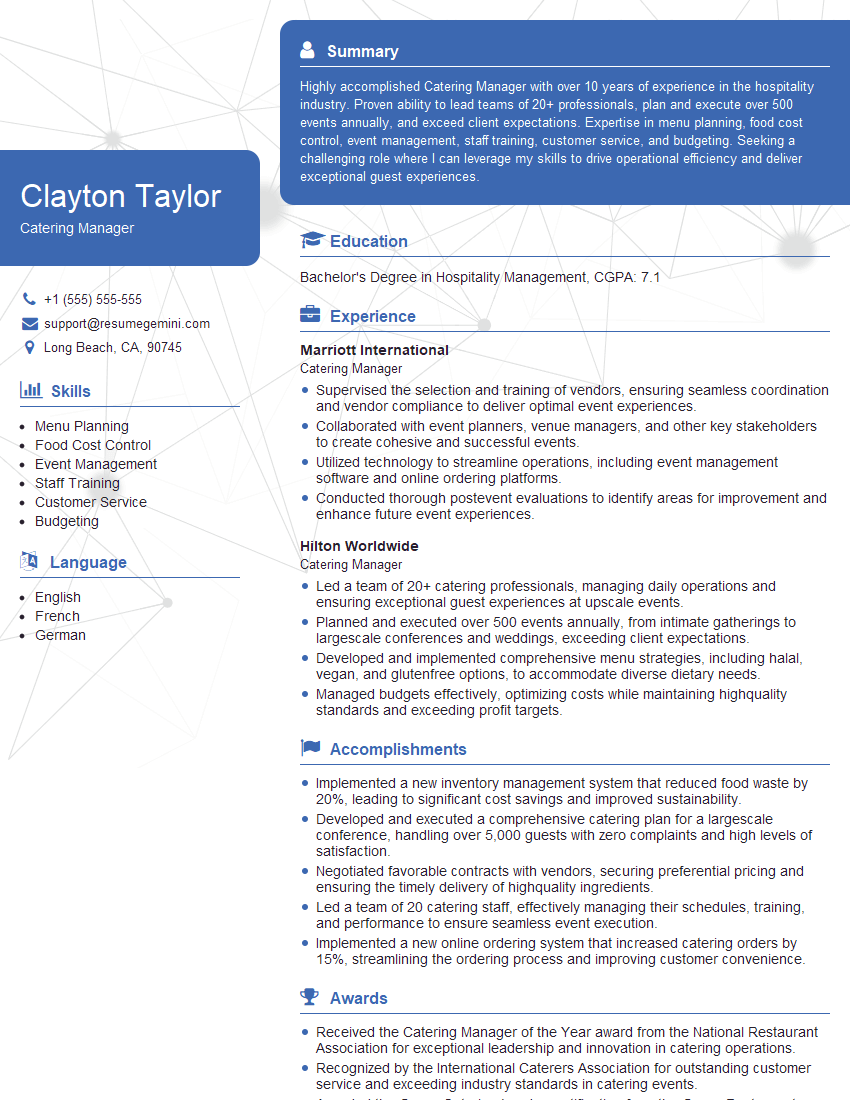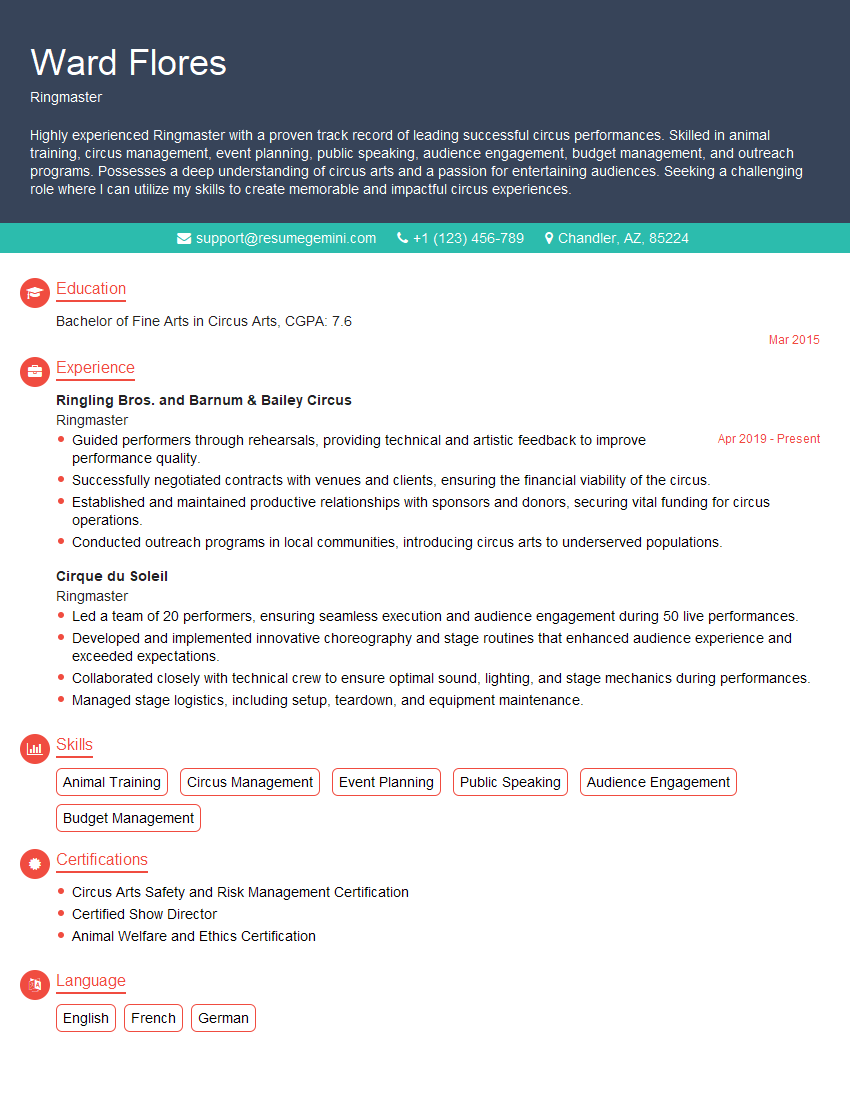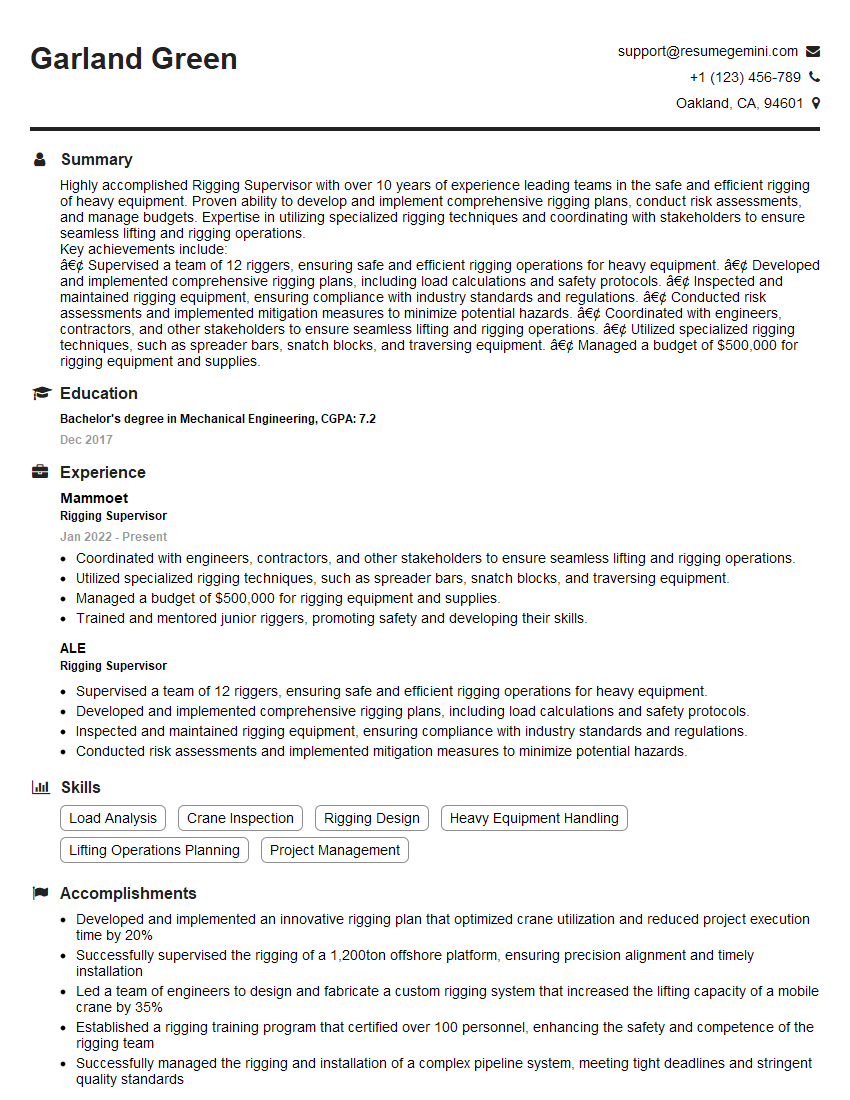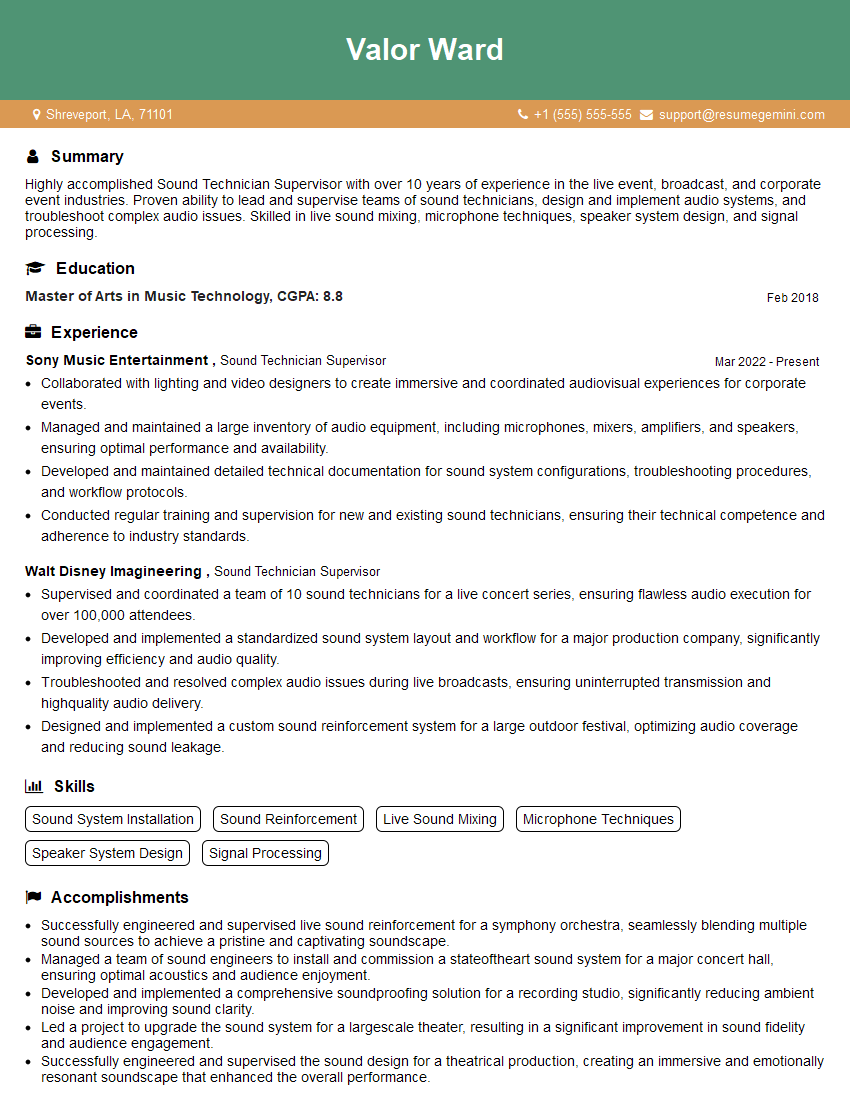Are you ready to stand out in your next interview? Understanding and preparing for Circus Management interview questions is a game-changer. In this blog, we’ve compiled key questions and expert advice to help you showcase your skills with confidence and precision. Let’s get started on your journey to acing the interview.
Questions Asked in Circus Management Interview
Q 1. Describe your experience managing a circus budget.
Managing a circus budget requires meticulous planning and control across numerous expense categories. It’s akin to managing a small city, considering everything from performer salaries and travel costs to animal care, venue rental, marketing, and insurance.
My approach begins with a comprehensive budget template that breaks down all anticipated expenses. This includes fixed costs like salaries and venue rentals, and variable costs like marketing campaigns and travel based on tour schedules. I then track actual expenses against the budget using accounting software, generating regular reports to identify potential overspending and adjust accordingly. For instance, during one tour, I negotiated discounted lodging rates with several hotels by leveraging the volume of our bookings, resulting in a substantial saving.
I also incorporate contingency planning into the budget, allocating a percentage (typically 5-10%) for unexpected costs, like medical emergencies or equipment repairs. This proactive measure prevents financial crises in case of unforeseen events. Regular review and adjustment of the budget based on performance data are key to ensuring financial stability and success.
Q 2. How would you handle a critical safety incident during a performance?
Responding to a critical safety incident during a performance demands immediate, calm, and decisive action. My priority is always the safety and well-being of the audience, performers, and crew. I’ve established and regularly rehearse emergency protocols with the entire team, covering every contingency from minor accidents to major incidents.
The first step is to activate the emergency response plan. This usually involves immediately halting the performance and securing the area. Medical personnel, if present, will provide immediate first aid. If not, I’ll coordinate with nearby emergency services. Simultaneously, I’ll communicate clearly with the audience, maintaining order and providing reassurance. If the incident is serious, I’ll implement a controlled evacuation procedure, guiding the audience to safety efficiently and calmly.
Following the immediate response, a thorough investigation will be conducted to ascertain the cause of the incident and implement preventive measures to prevent recurrence. This includes reviewing safety procedures, equipment maintenance logs, and performer training records. Documentation of the entire event, including witness statements and medical reports, is crucial for insurance purposes and future risk assessment.
Q 3. Explain your process for scheduling rehearsals and performances.
Scheduling rehearsals and performances requires a well-structured timeline that considers the complexity of the acts, the needs of the performers, and the logistical demands of touring. It’s a carefully choreographed dance, balancing artistic excellence with operational efficiency.
I begin by creating a master schedule that allocates sufficient rehearsal time for each act, building in time for individual practice, group rehearsals, and technical run-throughs. I schedule rehearsals strategically, considering travel time between venues and allowing for rest days to prevent performer burnout. For example, a physically demanding act like the trapeze might require more recovery time between rehearsals.
Performance scheduling depends on venue availability, local regulations, and marketing strategies. I use specialized scheduling software that helps visualize the timeline and optimize performance frequency and location to maximize audience reach and minimize logistical challenges. The master schedule is then shared with all performers and crew, ensuring transparency and coordinated efforts.
Q 4. What strategies do you use to promote a circus show?
Promoting a circus show involves a multi-faceted marketing strategy that leverages various channels to reach a wide audience. It’s about creating excitement and anticipation for the unique spectacle that is a circus. I believe in a holistic approach incorporating traditional and digital methods.
Traditional methods include print advertising in local newspapers and magazines, radio ads, and partnerships with local businesses. We often arrange meet-and-greets with performers at local events to foster community engagement and generate buzz. Digital marketing plays a significant role, involving a strong online presence through a professionally designed website and active social media campaigns on platforms like Facebook, Instagram, and TikTok. Compelling visuals and short video clips showcasing the unique aspects of our show are crucial for capturing attention.
Furthermore, I utilize email marketing to reach our database of subscribers and offer early-bird discounts to incentivize early ticket purchases. Collaborating with influencers and bloggers who can create viral content is another successful strategy. Measuring the effectiveness of each marketing channel is crucial, allowing me to refine the strategy to maximize return on investment.
Q 5. How do you manage relationships with performers and crew members?
Managing relationships with performers and crew members requires fostering a collaborative environment built on mutual respect, clear communication, and fair treatment. It’s about building a team, not just managing individuals. I believe in a participative management style that values their input and concerns.
Open communication is vital. Regular meetings are conducted to address any concerns, discuss scheduling updates, and solicit feedback. I encourage an environment where performers and crew feel comfortable expressing their needs and ideas. For instance, I implemented a suggestion box to encourage feedback and suggestions on ways to improve show quality or working conditions.
Fair compensation and working conditions are essential for maintaining morale and motivation. We ensure that contracts are clear and fair, that schedules are reasonable, and that we provide access to appropriate health and safety resources. Celebrating successes and acknowledging individual contributions fosters a sense of team pride and collective achievement.
Q 6. What is your experience with animal welfare regulations in the circus?
My experience with animal welfare regulations in the circus is extensive, and adherence to these regulations is paramount. I am deeply committed to ensuring that any animals involved in our performances are treated humanely and with the utmost respect. This commitment begins with a thorough understanding of all relevant local, national, and international regulations pertaining to animal care and transportation.
We work closely with veterinary professionals to provide regular check-ups, vaccinations, and necessary medical care. Our animal enclosures meet or exceed all stipulated standards for space, sanitation, and enrichment, and we have strict protocols for feeding, training, and handling animals. Each animal’s health and welfare is consistently monitored, and we maintain meticulous records of every aspect of their care.
We prioritize ethical training methods that emphasize positive reinforcement and avoid any form of cruelty or coercion. We conduct regular inspections by independent animal welfare organizations to ensure our practices meet the highest standards and to identify areas for continuous improvement. Transparency is vital; we welcome external scrutiny to demonstrate our commitment to animal welfare.
Q 7. Describe your experience in risk assessment and mitigation in a circus environment.
Risk assessment and mitigation are integral to safe circus operations. It’s about proactively identifying potential hazards and implementing measures to minimize or eliminate them. My approach is systematic and multi-layered.
The process begins with a thorough identification of potential hazards across all aspects of the circus, from performance acts and equipment to backstage areas and audience seating. I utilize a structured risk assessment matrix to evaluate each hazard based on its likelihood and potential severity. This matrix helps prioritize risks and allocate resources effectively.
Mitigation strategies are then developed for each identified hazard. This may involve modifying equipment, improving training procedures, implementing safety protocols, purchasing safety equipment, or adjusting performance routines. For example, we might use safety nets for aerial acts, implement strict crowd control measures, or provide rigorous training for handling pyrotechnics. Regular review and updates of the risk assessment matrix are crucial to ensure ongoing safety.
Q 8. How would you handle a conflict between two performers?
Handling conflicts between performers requires a calm, fair, and decisive approach. My strategy involves a three-step process: First, I facilitate a private meeting with the involved performers to understand the root of the conflict, encouraging open communication and active listening. I act as a neutral mediator, focusing on the issue at hand, not assigning blame. Second, once the issue is understood, I collaborate with the performers to develop a mutually acceptable solution. This might involve adjusting performance schedules, clarifying roles, or implementing new communication protocols. Third, I follow up to ensure the solution is working and to offer ongoing support. For example, if a scheduling conflict arises between a trapeze artist and a clown, I might adjust their rehearsal times to minimize overlap or establish a clear communication channel to coordinate their performances. A clear, consistent approach ensures professional harmony within the troupe.
Q 9. What is your experience with event permitting and licensing for circuses?
Event permitting and licensing for circuses is a complex process that varies significantly by jurisdiction. My experience encompasses securing all necessary permits and licenses, including those related to animal welfare, public safety, and environmental impact. This involves detailed applications, adherence to strict regulations, and ongoing communication with local authorities. For example, when touring internationally, I’ve had to navigate different sets of animal transport regulations, fire safety codes, and noise ordinances. I meticulously document all permits, licenses, and inspections to ensure full compliance and proactively address potential issues before they escalate. Proactive planning and clear communication are crucial for successful navigation of this complex regulatory landscape.
Q 10. How do you ensure the timely setup and breakdown of circus equipment?
Timely setup and breakdown of circus equipment is paramount for efficient touring. I utilize a detailed, colour-coded schedule, assigning specific tasks and timelines to each crew member. This schedule is meticulously planned considering the unique needs of each piece of equipment and potential logistical challenges of the venue. We conduct regular rehearsals to optimize setup and breakdown procedures, focusing on safety and efficiency. For instance, our rigging crew has a designated checklist and adheres to specific safety protocols for every piece of equipment, ensuring swift and safe operation. Using technology, such as a shared digital schedule accessible by all team members, provides real-time updates and helps maintain consistent communication and accountability throughout the process. Regular equipment maintenance is also crucial to minimize delays and ensure safety.
Q 11. Describe your experience in managing logistics for a traveling circus.
Managing logistics for a traveling circus is akin to orchestrating a complex symphony. It involves coordinating transportation of performers, animals (if applicable), equipment, and supplies across multiple locations. This requires meticulous planning, including securing reliable transportation, arranging accommodation, and managing travel itineraries. We use specialized software to track equipment inventory, schedule maintenance, and optimize routes. In one instance, when transporting our big top across several states, we carefully planned routes to avoid low bridges and weight restrictions, while also coordinating with local authorities for safe passage. Effective communication and collaboration with various transportation providers are critical for success. Contingency planning is also key; having backup transportation and accommodation options helps mitigate potential delays and disruptions.
Q 12. What are your strategies for marketing and advertising a circus show to diverse audiences?
Marketing and advertising a circus to diverse audiences requires a multi-faceted approach. We tailor our marketing messages to resonate with specific demographics, leveraging various channels such as social media, local newspapers, and radio. For example, we might use vibrant, family-friendly visuals to appeal to families, while highlighting the athleticism and skill of our performers to attract a younger audience. We also offer discounted tickets to community groups and schools to ensure accessibility for diverse audiences. Partnerships with local businesses and community organizations extend our reach and build trust within the community. Data analysis of previous campaigns provides valuable insights to refine our marketing strategies and maximize our reach and effectiveness.
Q 13. How do you manage the financial aspects of a circus tour?
Managing the financial aspects of a circus tour requires careful budgeting, meticulous expense tracking, and proactive revenue generation. I develop a comprehensive budget that includes all anticipated costs (travel, accommodation, salaries, marketing, etc.) and projected revenue from ticket sales, sponsorships, and merchandise. Regular financial reports track income and expenses, ensuring we stay within budget and identify potential cost-saving measures. Diversification of revenue streams is essential, exploring opportunities like corporate sponsorships and concessions to mitigate financial risks. We use accounting software to manage finances efficiently, providing real-time insights into the tour’s financial health. Proactive financial planning and monitoring are crucial for the success and sustainability of the circus tour.
Q 14. How do you maintain the safety and well-being of performers and animals?
Maintaining the safety and well-being of performers and animals is the highest priority. For performers, this involves providing comprehensive safety training, ensuring appropriate safety equipment is used, and regularly inspecting performance areas. We enforce strict safety protocols and have contingency plans in place to address potential emergencies. If animals are involved, we adhere to all relevant animal welfare regulations, ensuring they receive proper care, nutrition, and veterinary attention. Regular inspections of animal enclosures and performance areas are conducted to maintain high standards of hygiene and safety. A dedicated team is responsible for animal welfare, ensuring their physical and emotional well-being is prioritized at all times. Our commitment to safety and welfare is reflected in our meticulous planning, regular inspections, and adherence to best practices.
Q 15. Explain your knowledge of relevant health and safety regulations for circuses.
Health and safety are paramount in circus management. My understanding encompasses a wide range of regulations, varying by location but generally focusing on animal welfare (if applicable), performer safety, audience safety, and equipment safety. This includes adherence to OSHA (Occupational Safety and Health Administration) guidelines in the US, or equivalent regulations in other countries.
- Animal Welfare: If the circus includes animals, rigorous standards must be met regarding their housing, care, training, and transportation. This often involves inspections by animal welfare organizations and compliance with specific acts and regulations related to preventing cruelty and ensuring their well-being. For example, ensuring adequate space, proper nutrition, enrichment activities, and veterinary care.
- Performer Safety: This involves risk assessments for all acts, providing appropriate safety equipment (harnesses, nets, protective gear), and ensuring performers receive adequate training and are physically capable of performing their acts. Regular safety briefings and emergency procedures are crucial.
- Audience Safety: This involves maintaining safe seating arrangements, clear evacuation routes, emergency exits, fire safety measures, and crowd control. Regular inspections of the venue’s structure and adherence to fire codes are vital.
- Equipment Safety: Regular maintenance and inspection of all equipment – from rigging and lighting to sound systems and animal enclosures – are critical. Ensuring equipment is properly certified and operated by trained personnel is mandatory to prevent accidents.
Failure to comply with these regulations can lead to hefty fines, suspension of operations, and reputational damage. Proactive safety measures are far more cost-effective than reacting to accidents.
Career Expert Tips:
- Ace those interviews! Prepare effectively by reviewing the Top 50 Most Common Interview Questions on ResumeGemini.
- Navigate your job search with confidence! Explore a wide range of Career Tips on ResumeGemini. Learn about common challenges and recommendations to overcome them.
- Craft the perfect resume! Master the Art of Resume Writing with ResumeGemini’s guide. Showcase your unique qualifications and achievements effectively.
- Don’t miss out on holiday savings! Build your dream resume with ResumeGemini’s ATS optimized templates.
Q 16. How do you build and maintain relationships with local communities?
Building strong community relationships is essential for a circus’s long-term success. We employ a multi-pronged approach:
- Community Engagement: We actively participate in local events, sponsor community initiatives, and offer discounted tickets to local schools and charities. This helps us become a valued part of the community.
- Open Communication: We maintain open lines of communication with local authorities, residents, and businesses. We address concerns promptly and transparently, building trust and goodwill. This often involves attending town hall meetings and proactively communicating our plans.
- Collaboration: We collaborate with local businesses for sponsorship opportunities and promotional collaborations. We might partner with local restaurants, hotels, and other businesses to offer packages or discounts.
- Charitable Contributions: We make donations to local charities and support community-based initiatives. This enhances our reputation and demonstrates our commitment to the community’s well-being.
For example, we once partnered with a local school to offer a circus-themed workshop for their students, creating a positive and memorable experience for both the school and our organization.
Q 17. How would you handle negative media coverage of a circus?
Negative media coverage can significantly impact a circus’s reputation. My approach involves a swift and transparent response:
- Assess the Situation: Immediately analyze the nature and extent of the negative coverage. Identify the specific concerns raised.
- Develop a Response Strategy: Craft a factual and empathetic response addressing the concerns directly. Avoid being defensive or dismissive.
- Public Statement: Issue a public statement acknowledging the issue and outlining the steps being taken to address it. This might involve an apology if appropriate, along with a detailed explanation of corrective actions.
- Proactive Communication: Engage with media outlets and individuals expressing concerns. Answer questions honestly and transparently.
- Internal Review: Conduct an internal review to identify the root cause of the issue and implement preventative measures to avoid future occurrences.
For instance, if an animal welfare concern is raised, a detailed response outlining the animal’s care, veterinary records, and training methods would be necessary to demonstrate compliance with regulations and best practices. Transparency and immediate action are key to mitigating the damage.
Q 18. What is your experience with contract negotiation for performers and vendors?
Contract negotiation is a crucial aspect of circus management. My experience involves:
- Clear Agreements: Drafting legally sound contracts that clearly define the scope of work, payment terms, responsibilities, and liabilities for both performers and vendors. This includes specifics on performance dates, cancellation clauses, and intellectual property rights.
- Fair Compensation: Negotiating fair and competitive compensation packages that are aligned with industry standards and the performer’s or vendor’s experience and expertise. This often involves understanding prevailing market rates and factoring in travel, accommodation, and other relevant expenses.
- Risk Management: Incorporating clauses that address potential risks and liabilities, such as insurance requirements, indemnification, and dispute resolution mechanisms. This safeguards both the circus and the other party involved.
- Relationship Building: Cultivating strong relationships with performers and vendors, ensuring mutual respect and understanding throughout the negotiation process. This fosters long-term partnerships and smoother collaborations.
I have successfully negotiated contracts with international performers, securing their participation in our shows while adhering to visa requirements and international labor laws. It’s a balancing act between securing talent and ensuring financial viability for the circus.
Q 19. Describe your process for selecting and managing a circus’s talent.
Talent selection and management is a rigorous process:
- Auditions and Reviews: We hold auditions or review submitted materials to assess performers’ skills, experience, and suitability for our shows. This often involves a panel of judges with expertise in various circus disciplines.
- Contract Negotiation: Once we identify suitable talent, we engage in contract negotiations to outline performance details, compensation, and other relevant terms.
- Training and Rehearsals: We provide adequate training and rehearsal time to ensure performers are well-prepared for their performances and that the show runs smoothly. This may include working with specialized coaches or trainers.
- Performance Monitoring: During the shows, we monitor performers’ performances to ensure their safety and adherence to standards. We provide constructive feedback and address any concerns promptly.
- Performance Evaluation: We regularly evaluate the performers’ performances and provide feedback to help them improve their skills and adapt to changing show requirements.
For example, we once discovered a talented young acrobat through a local competition. We mentored them, provided advanced training, and helped them develop their act, ultimately featuring them in our main show.
Q 20. How do you handle unexpected technical difficulties during a show?
Unexpected technical difficulties are inevitable. My approach is based on preparedness and quick thinking:
- Redundancy: We incorporate redundancy into our technical systems wherever possible. Having backup generators, lighting equipment, and sound systems minimizes disruption.
- Technical Crew: A highly skilled and experienced technical crew is essential. They are trained to handle a variety of issues quickly and efficiently.
- Contingency Plans: We develop contingency plans for common technical issues. These plans detail alternative procedures and solutions to minimize show interruptions.
- Communication: Clear communication channels between the technical crew, stage manager, and performers are vital. This ensures everyone is aware of any problems and can respond accordingly.
- Audience Management: If a significant delay is unavoidable, we communicate with the audience, explaining the situation and offering appropriate compensation or alternative arrangements if necessary. Transparency is key in maintaining audience goodwill.
For instance, during a storm, our backup generator immediately took over, ensuring the show continued with minimal interruption. Our technical team’s swift response and pre-planning minimized audience disruption.
Q 21. How do you ensure the security of circus equipment and assets?
Securing circus equipment and assets is crucial. Our strategy includes:
- Physical Security: We use a combination of physical security measures, including secure storage facilities, locks, alarms, and surveillance cameras to protect our equipment and assets during transportation and storage.
- Inventory Management: A detailed inventory system tracks all equipment and assets. This makes it easy to identify missing or damaged items and facilitates insurance claims if necessary.
- Personnel Security: Background checks are conducted on all personnel to ensure their trustworthiness. Access to sensitive areas is restricted to authorized individuals.
- Insurance: Comprehensive insurance coverage protects against theft, damage, and other potential losses. This includes liability insurance to protect against potential claims from accidents or injuries.
- Transportation Security: Secure transportation arrangements are made to protect equipment during transit. This might involve using secured vehicles and employing security personnel during transport.
For example, we use GPS tracking on our transport vehicles, allowing us to monitor their location and ensure the safe arrival of our equipment at each venue.
Q 22. What experience do you have with emergency planning and response in a circus setting?
Emergency planning and response are paramount in a circus environment, given the inherent risks associated with live performances and complex equipment. My approach involves a multi-layered strategy, starting with a comprehensive risk assessment identifying potential hazards – from animal escapes and equipment malfunctions to audience emergencies and weather-related incidents.
This assessment informs the development of detailed emergency protocols, including evacuation plans, communication strategies, and designated roles and responsibilities for all staff members. We conduct regular drills, ensuring staff proficiency in executing these plans. For example, we simulate a fire evacuation, practicing clear communication pathways and efficient crowd management to ensure minimal panic and maximum safety. We also maintain a well-stocked first-aid station and have established relationships with local emergency services, ensuring swift response times should a major incident occur. Finally, we regularly review and update our emergency plans based on lessons learned from drills and any actual incidents, adapting to changing circumstances and evolving best practices.
Q 23. Describe your familiarity with different circus acts and their technical requirements.
My familiarity with circus acts spans a wide range, encompassing both traditional and contemporary forms. I have extensive experience with animal acts (always adhering to ethical and legal standards), acrobatic performances, aerial acts (trapeze, silks, etc.), clowning, juggling, and equestrian displays. Understanding the technical requirements of each act is crucial for effective management. This includes knowledge of rigging and safety procedures for aerial acts, stage management for animal entries and exits, sound and lighting coordination, and ensuring proper staging and props are in place. For example, for an aerial silk act, I oversee the rigorous inspection of the silks, the correct weight limits, and the presence of certified riggers to guarantee the safety of the performer.
- Acrobatic Acts: Requires careful spotter placement and safety mats.
- Animal Acts: Demands meticulous animal care, training, and handling protocols.
- Equine Acts: Necessitates specialized handling equipment and veterinary support.
This knowledge allows me to effectively allocate resources, manage schedules, and address any technical issues that may arise during rehearsals or performances.
Q 24. How do you manage the maintenance and repair of circus equipment?
Maintaining circus equipment is critical for safety and the smooth running of shows. We employ a proactive maintenance strategy, combining regular inspections with scheduled repairs and preventative maintenance. This involves detailed checklists for each piece of equipment, specifying inspection frequency and criteria.
We maintain a detailed inventory of all equipment, tracking its age, condition, and maintenance history. Repairs are undertaken either by our in-house technicians or by specialized external contractors, depending on the complexity of the work. All repairs are documented, and we adhere to strict safety regulations, ensuring equipment is in optimal working order before each performance. For example, we use a detailed tracking system for our rigging equipment, including regular load testing and certification to avoid catastrophic failure.
Regular equipment servicing is as important as immediate repair. A well-maintained trapeze is far safer and lasts far longer, reducing replacement costs and preventing downtime.
Q 25. What is your approach to creating a positive and productive work environment for circus staff?
Creating a positive and productive work environment is paramount. My approach centers on open communication, mutual respect, and clear expectations. We foster a team-oriented culture where staff feel valued and empowered. This involves regular team meetings to address concerns, celebrate successes, and brainstorm improvements. We promote open dialogue, ensuring everyone feels comfortable voicing opinions and concerns. Fair compensation, equitable workload distribution, and opportunities for professional development are also integral to this strategy. We encourage team-building activities both on and off the job, fostering camaraderie and stronger working relationships. I believe a happy team leads to better performances and a more engaging experience for the audience.
Q 26. How do you measure the success of a circus show?
Measuring the success of a circus show involves a multifaceted approach, extending beyond mere ticket sales. While box office revenue is an important indicator, we also consider audience engagement, critical reviews, and repeat viewership.
Audience surveys and feedback mechanisms provide valuable insights into audience satisfaction and areas for improvement. We also monitor social media mentions and online reviews to gauge public perception. Ultimately, a successful show is one that entertains, thrills, and leaves a lasting positive impression on the audience, while ensuring the safety and well-being of performers and staff.
- Ticket Sales: A key measure of overall attendance and popularity.
- Audience Feedback: Surveys and reviews provide qualitative data on experience.
- Social Media Engagement: Measures public perception and online buzz.
- Critical Acclaim: Professional reviews assess the quality of the performances.
Q 27. Describe your experience with managing a team of diverse individuals in a fast-paced environment.
Managing a diverse team in a fast-paced environment requires strong leadership skills, excellent communication, and an understanding of individual needs and motivations. I emphasize clear roles, responsibilities, and expectations, ensuring everyone understands their contribution to the overall success of the show. I foster an inclusive environment where diversity is celebrated and individual talents are recognized and utilized.
Effective communication is crucial; this involves regular updates, open forums for discussion, and addressing conflicts promptly and fairly. Delegation is key, empowering team members to take ownership of their tasks. Flexibility and adaptability are vital in the fast-paced world of circus management, requiring the ability to respond quickly to changes in schedules, logistics, or unforeseen challenges. For instance, managing performers from diverse cultural backgrounds requires sensitivity and cultural awareness to foster a respectful and harmonious working environment.
Q 28. What is your understanding of the legal and ethical considerations in circus operations?
Legal and ethical considerations are paramount in circus operations. This includes adhering to all relevant animal welfare laws and regulations, ensuring the safety of performers and audience members, and complying with labor laws and workplace safety standards. We prioritize ethical sourcing of materials and maintain transparent and honest business practices.
For instance, all animal acts are subject to rigorous inspections and must meet specific welfare standards, including adequate living conditions, proper training methods, and veterinary care. We maintain comprehensive insurance coverage to mitigate potential risks and liabilities. Staying updated on evolving legislation and best practices is an ongoing process, ensuring we remain compliant and maintain the highest ethical standards in all aspects of our operations.
Key Topics to Learn for Your Circus Management Interview
- Show Production & Logistics: Understanding the intricacies of planning, scheduling, and executing a circus performance. This includes budgeting, risk assessment, and coordinating various technical aspects like lighting, sound, and rigging.
- Animal Welfare & Handling (if applicable): Demonstrating knowledge of ethical animal care practices, relevant regulations, and safe handling procedures. This may involve understanding training methods, veterinary care, and compliance with local and national laws.
- Artist Management & Contracts: Experience in negotiating contracts, managing performer schedules, and addressing performer needs and concerns. This includes understanding legal implications and maintaining positive working relationships.
- Marketing & Sales: Developing and implementing effective marketing strategies to attract audiences, manage ticket sales, and build brand awareness. This requires an understanding of market trends and effective advertising techniques.
- Financial Management & Budgeting: Demonstrating proficiency in creating and managing budgets, tracking expenses, and ensuring financial stability for the circus operation. This involves forecasting revenue, managing costs, and understanding financial reporting.
- Risk Management & Safety Procedures: Developing and implementing comprehensive safety protocols to mitigate risks associated with circus performances. This involves emergency preparedness, accident prevention, and ensuring compliance with safety regulations.
- Team Management & Leadership: Highlighting experience in leading and motivating diverse teams, fostering collaboration, and resolving conflicts effectively. This involves communication, delegation, and conflict resolution skills.
Next Steps
Mastering Circus Management opens doors to exciting career opportunities within a dynamic and creative industry. To maximize your job prospects, it’s crucial to present your skills and experience effectively. An ATS-friendly resume is your first step towards getting noticed by potential employers. ResumeGemini can help you craft a compelling resume that showcases your unique qualifications within this niche field. We provide examples of resumes tailored to Circus Management to help you get started. Invest the time to build a strong resume – it’s your key to unlocking your dream Circus Management role.
Explore more articles
Users Rating of Our Blogs
Share Your Experience
We value your feedback! Please rate our content and share your thoughts (optional).
What Readers Say About Our Blog
Hi, I represent an SEO company that specialises in getting you AI citations and higher rankings on Google. I’d like to offer you a 100% free SEO audit for your website. Would you be interested?
Hi, I represent an SEO company that specialises in getting you AI citations and higher rankings on Google. I’d like to offer you a 100% free SEO audit for your website. Would you be interested?
Dear Sir/Madam,
Do you want to become a vendor/supplier/service provider of Delta Air Lines, Inc.? We are looking for a reliable, innovative and fair partner for 2025/2026 series tender projects, tasks and contracts. Kindly indicate your interest by requesting a pre-qualification questionnaire. With this information, we will analyze whether you meet the minimum requirements to collaborate with us.
Best regards,
Carey Richardson
V.P. – Corporate Audit and Enterprise Risk Management
Delta Air Lines Inc
Group Procurement & Contracts Center
1030 Delta Boulevard,
Atlanta, GA 30354-1989
United States
+1(470) 982-2456
